November 21, 2018
List of Blogs
|<
<
>
>|
|
|
The Boundless Benefits of a Brush Pile
|
|
That's right, brush piles! They are terrific for wildlife in so many ways, and can enhance
your own garden experience. I know what you're thinking; what can possibly be good about a
brush pile? Let's talk about it!
|
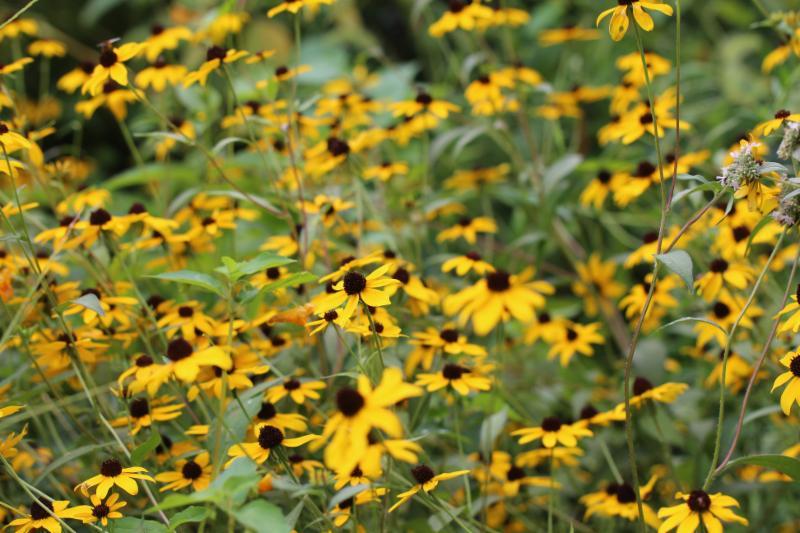
In this cold snap, we already miss summer
flowers like this Thin-leaved Coneflower (Rudbeckia triloba), but their
seedheads provide an important wintertime food source for birds.
|
|
Last month, we addressed fall cleanup of the garden and, as usual, advocated that you take
a
light touch.
Whatever you do, we said, don't just bag up all your branches, stems, sticks,
and leaves and put them out to be picked up with the trash. First of all, there really is no
point in filling up our landfills with perfectly biodegradable biomass that can better serve
your garden (and the environment!) by being left in in place. Secondly, if you send all of
your garden debris to the curb, you will be actively removing wildlife from your garden.
Almost all of the butterflies, native bees, and other pollinators that you enticed into
your garden over the summer will also overwinter in your garden, but only if you let them.
|
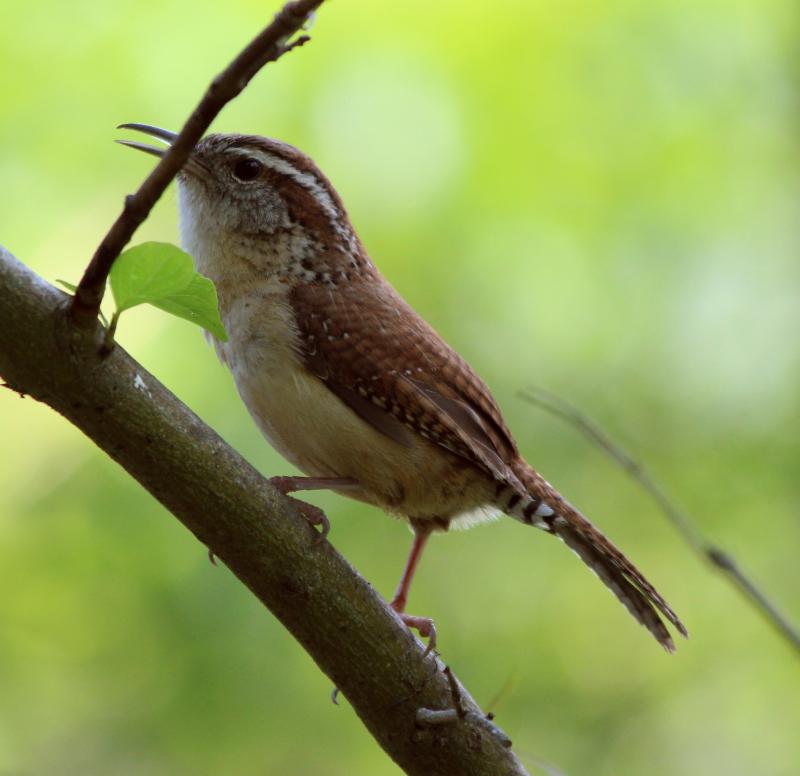
Carolina Wrens (Thryothorus ludovicianus) love
brush piles, and will almost certainly let you know when they take up residence
|
|
We understand, that for aesthetic and other reasons, some cleanup is required...
It's true that if you don't rake your leaves all fall, and they blow away onto your neighbors'
properties...you may find yourself having awkward and unpleasant conversations with the neighbors.
Dormant stems that fall across the walkway are also not attractive all winter long, so if you
leave everything as is, you may also find yourself having unpleasant and awkward conversations
with your relatives! You want to encourage wildlife on your property, but you also want to clean
up your leaves and cut back at least some stems to tidy up the property before winter. So what
are you to do?
|
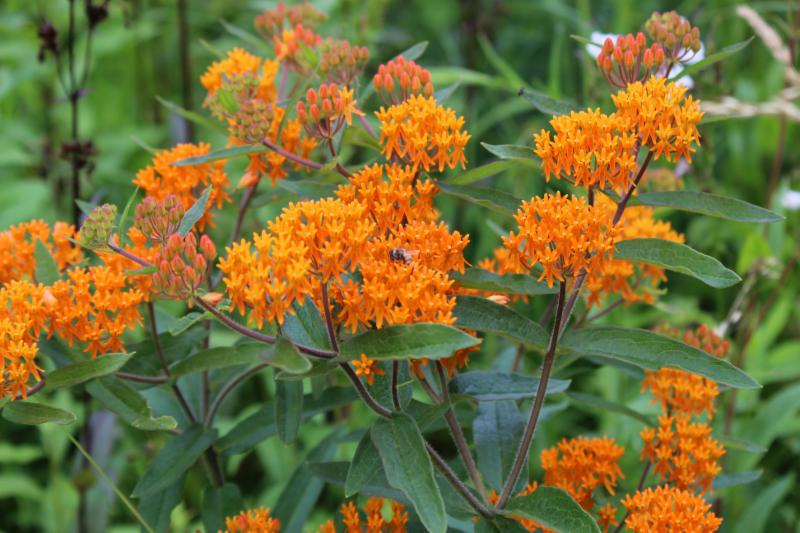
A Butterfly Milkweed (Asclepias tuberosa) in the
Toadshade meadow last summer. For obvious reasons, plants can't look this glorious all year long,
but it would certainly make fall cleanup easier!
|
|
Make a Brush Pile, and Wildlife Will Love You!
When I was a kid, brush piles were pretty common--on farms, yes, but in small suburban and urban
backyards as well. Biodegradable branches and stems were not thrown out with the trash, but rather
added to the perpetual bush pile. My dad would rake up the leaves, pick up any fallen branches and
sticks, and simply make 2 large piles (one for sticks, one for leaves) on the edge of our yard next
to the neighbor's woods. Over time they would settle, but there were always more leaves, more stems,
and more branches to add on top. Brush piles are simple to make and the
rewards
(we're getting to that part!) are wonderful. So what wildlife, exactly, do they benefit?
|
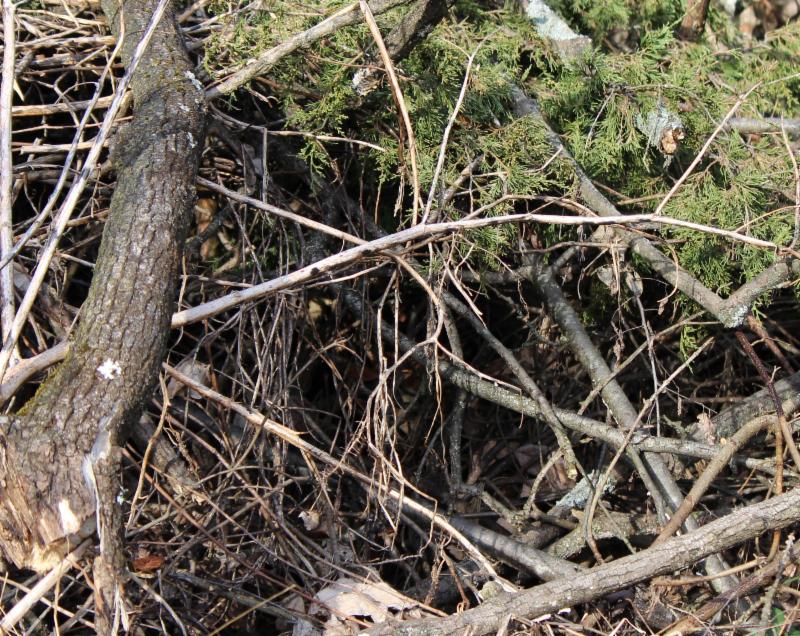
Brush piles may not look like much to us, but to wildlife, birds,
and beneficial insects, they look like wonderful sources of shelter and food.
|
|
Butterflies, Pollinators, & Beneficial insects
Instead of literally throwing out your overwintering butterflies with the trash,
putting spent flower stems in the brush pile will allow the attached pupae (chrysalises)
to overwinter on your property. Additionally, some of our favorite spring butterflies,
such as the Mourning Cloak (Nymphalis antiopa) and the 'punctuation' butterflies
(ie. the Question Mark (Polygonia interrogationis), Eastern Common (Polygonia
comma), and Gray Comma (Polygonia progne)) overwinter as adults--and will find
cover in your brush pile! The solitary bees that have so carefully created nest space
in some of the hollow flower stems in your garden will overwinter just fine if you cut
those stems and place them in your brush pile. Ground beetles, praying mantises, even
fireflies (aka lightning bugs) will benefit from your brush pile. In the case of
fireflies, some species like to lay their eggs on rotting wood, and firefly larvae
are great predators of slugs and snails. All kinds of beautiful and beneficial insects
will enhance your garden if you give them a brush and leaf pile.
|
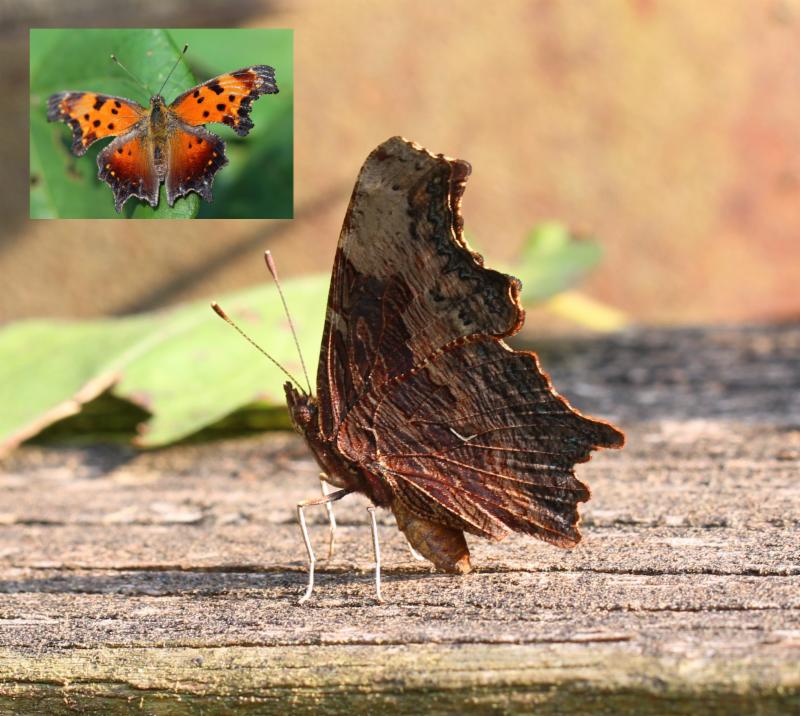
Grey Commas (Polygonia progne) like this one are
quite rare in our area, and overwinter as adults in sheltered areas (such as brush piles). Like
their cousins, the other 'punctuation' butterflies, the underside of their wings camouflage them
well, but when they open and spread their wings they are quite bright -- so keep an eye out for
flashes of orange both late in the season and early in the spring!
|
|
Birds
I can always count on Carolina wrens to take up residence and announce their presence
musically from the top of the brush pile in early spring. But more than just wrens
frequent brush piles: by creating a brush pile, you will quickly find all kinds of birds
using it all year long for cover and nesting--juncos, white-throated sparrows, mockingbirds,
thrashers, warblers, cardinals--the list goes on and on. In the winter, seed-feeding birds
will eagerly feast on seeds of seed heads left standing in your gardens or placed in your
brush pile. Woodpeckers, nuthatches, and other birds will search for insects in the bark
and stems in your brush pile. Downy Woodpeckers and Black-capped Chickadees are extremely
fond of eating the larvae hiding inside Goldenrod Ball Galls (formed by the Goldenrod Gall
Fly, Eurosta solidaginis) on Canada Goldenrod (Solidago canadensis),
Giant Goldenrod (S. gigantea) and Late Goldenrod (S. altissima) stems.
Additionally, brush piles provide excellent emergency shelter for small birds when
Sharp-shinned or Cooper's hawks are hunting. You'll also find that, come spring,
birds will visit the brush pile to collect nesting material in the form of shredded
bark, small twigs, stem pieces, plant fiber, dried grass, and dried leaves.
|
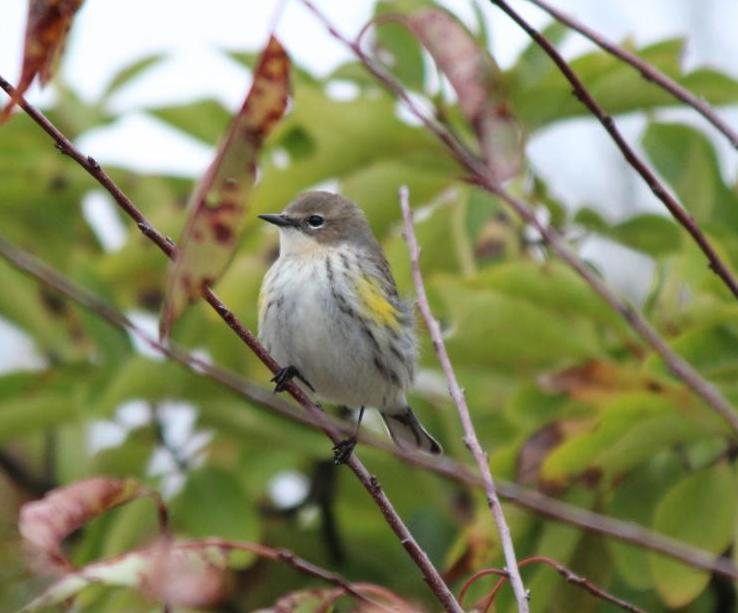
Providing shelter does as much as birdfeeders (if not more!)
to encourage birds in your yard. Small birds in particular, like this migratory yellow-rumped warbler (
Setophaga coronata) require refuge from weather and predators, and will happily take shelter
in a brush pile.
|
|
Other Critters
The 4 legged creatures that have used our brush piles over the years are often more subtle,
in many ways. I always enjoy checking around the base of the brush piles after a light snow
to see what footprints can be found. I don't pretend to be able to identify them all, but
there are clearly creatures great and small taking shelter in the brush pile: shrews, mice,
rabbits, opossum, and even foxes. Brush piles are a haven for Box Turtles and give both the
adults and young hatchling turtles protection. Salamanders and snakes (come on now, don't
'ew' about the snakes, they're crucial to the ecosystem!) will also take cover in a brush
pile, with salamanders and toads hiding in the moist areas under the bottommost layer.
|
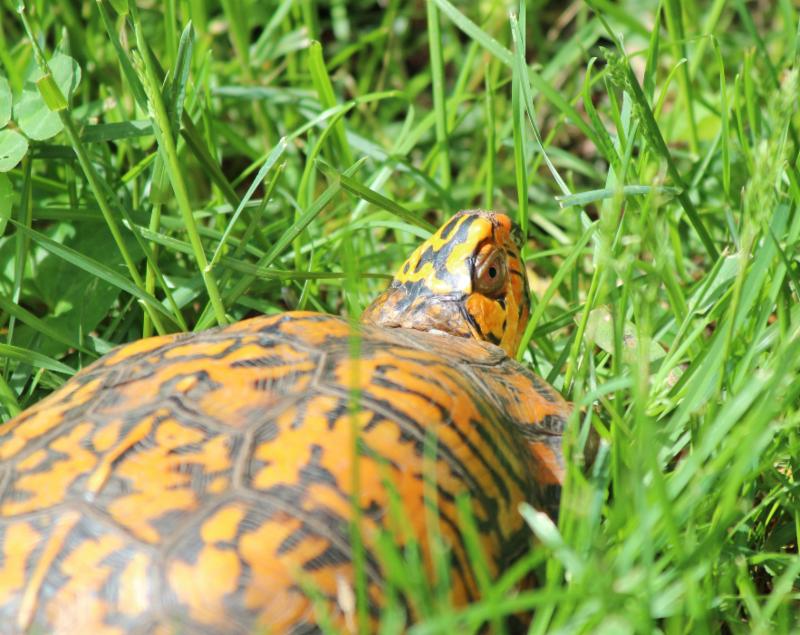
Box Turtles (Terrapine carolina) like to think
they're hiding in plain sight, but it's difficult when you're quite that orange.
|
|
And You!
A brush pile acts as a wonderful compromise between you and wildlife. Most gardens do require a
certain degree of curating in the fall and spring, and sometimes this can put wildlife-conscious
gardeners in a bit of a bind: do I encourage birds and solitary bees by leaving dormant stalks
standing, or do I cut some of them back so that the neighbors don't talk? Can I clear at least
some of these leaves to prepare for spring planting, or do I need to leave them all in place to
provide a winter home for my garden's beneficial insects and salamanders? What if I love
butterflies and wildlife, but I also love a tidy yard in wintertime??
|

As predators, toads help to keep the balance of insect
species at a healthy level in an ecosystem. They also specialize in giving irate looks.
|
|
Brush piles are, in some ways, as much for us as they are for wildlife. They give us peace
of mind that we can gently clean up our gardens without causing damage to the very creatures
we've been encouraging during the growing season. As gardeners, we like to work outside,
and it's difficult (and unnecessary) for us to put a blanket ban on yard work starting in
late October. Personally, I find that many winter stems are quite beautiful in their own
right, but I must admit that some are not. Rather than stewing all winter as you look at
some particularly unattractive corner of your gardens, you can simply clean up what you
need to, and add the stems to a brush pile. Unlike a garden, which is usually front and
center, a brush pile can be put wherever you want it. If you are the sort who will enjoy
watching birds use the shelter throughout the winter, place it where you can see and enjoy
the activity. If you would rather not see the brush pile, it can put in an inconspicuous
part of your yard. Because it is a single pile rather than a spread-out landscape of stems,
it can actually look quite tidy. And, because it is so supportive of birds, wildlife, and
insects, it will enliven and enhance your entire yard (and garden) all year long!
|
|
So, How Do You Build a Brush Pile?
Quite frankly, almost any pile of sticks and twigs will attract wildlife and give them a
place to shelter. There are all kinds of websites out there that will tell you how to build the
perfect brush pile. Now, you may laugh at that and acknowledge that there are probably also websites
that will give you instructions on how to pour water out of a boot, but there are simple steps
you can take to make your brush pile more enticing to wildlife.
|
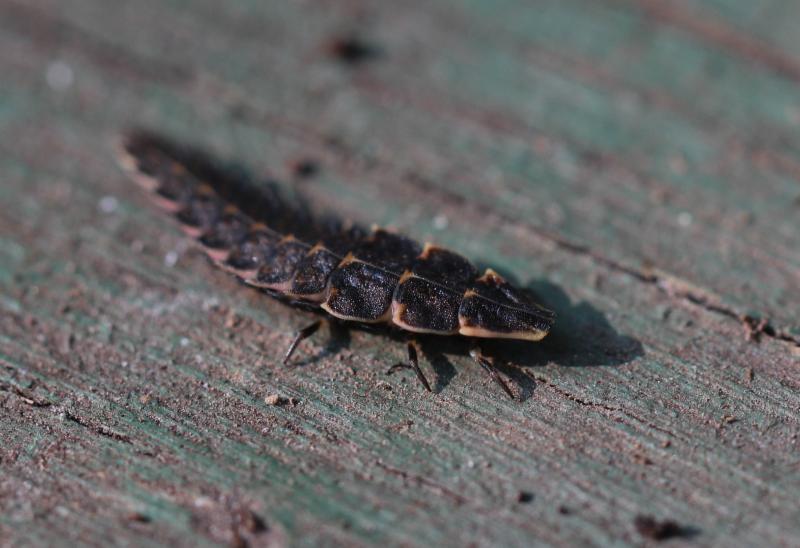
This dramatically armored little fellow is a Pennsylvania
Firefly larvae (Photuris pennsylvanica). In the larval stage, they mostly eat slugs and snails,
making them any gardener's friend!
|
|
In the end, building a brush pile for wildlife simply requires a little common sense:
- Don't put garbage or food scraps in your in your brush pile (a brush pile is not a garbage dump,
nor is it a compost heap). Also, don't shred and chip all of the stems, branches, and leaves before
putting them in the brush pile. Chipping/shredding will destroy all of the butterfly pupae,
overwintering native bees, and other beneficial insects that were hoping to overwinter in your
garden. Additionally, the chipped material will not form a brush pile, but rather a mulch pile.
- Although your wildlife will love it, your neighbors may not entirely embrace the aesthetic of a
brush pile. If you can, place it where you can enjoy watching the wildlife, but not in a location
that might offend neighbors. From the wildlife's point of view, placing your brush pile near the
woods edge (or even next to a hedge) is ideal.
- If you want to dress up your brush pile, plant native vines such as Virgin's Bower
(Clematis virginiana), Coral Honeysuckle (Lonicera sempervirens), Summer Grape
(Vitis aestivalis), Wild Yam (Dioscorea villosa), American Hops (Humulus lupulus),
Virginia Creeper (Parthenocissus quinquefolia), or Canada Moonseed (Menispermum canadense)
--these will clamber in and through your brush pile and provide beauty, shelter, and food for wildlife.
Thorny fruiting vines such as Northern Dewberry (Rubus flagellaris) and Roundleaf Greenbriar
(Smilax rotundifolia) will not only supply food for wildlife, but will help discourage predators
(such as feral cats) from preying on birds nesting in your brush pile.
- Leaves make a fine base level, and some can be added to a brush pile over time, but don't make your
brush pile and then bury it in an entire mountain of leaves. If you have too many leaves, you can make a
separate leaf pile and allow the leaves to decompose. Ground beetles, toads, snakes, salamanders, and
all manner of other creatures will also enjoy this pile. Over time, the leaves will completely decompose,
leaving you with a rich layer of compost much like a forest floor.
- To start a new brush pile, put the largest branches/logs on the bottom, and then build up from there.
The idea is to leave plenty of gaps from the ground up for creatures to enter and exit your brush pile.
|
|
And don't forget to leave at least some of the spent flower heads standing...
the seed-eating birds will love you. Leave as many of the stalks in place as you can, so that some
of the solitary bees can overwinter inside those stems in peace, and your butterfly pupae will still
have a place to literally 'hang out' for the winter. But for the stems you don't want? Now is a great
time to start on that brush pile! You will be surprised at how quickly the birds will discover it. All
of your beneficial insects will thank you, and you can safely look forward to seeing those overwintering
butterflies again in the spring.
|

And don't worry! Summer will be back before you know it...
|
|
|



